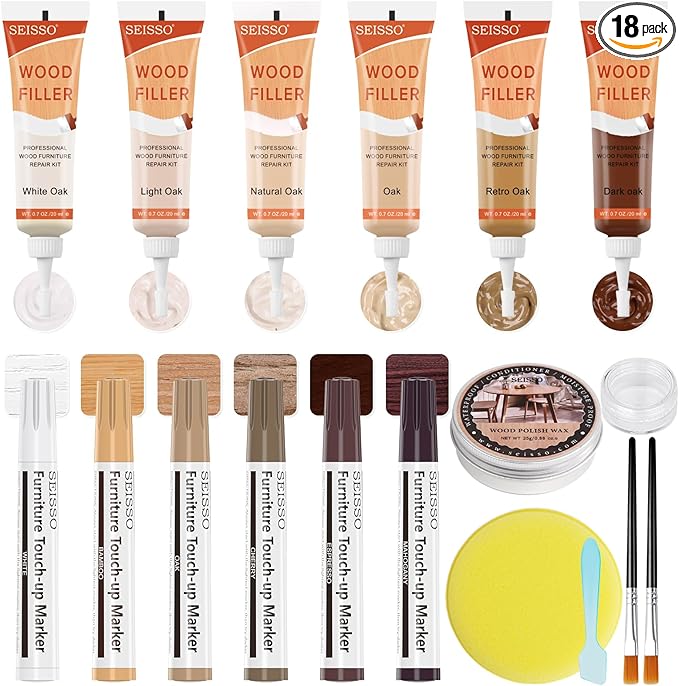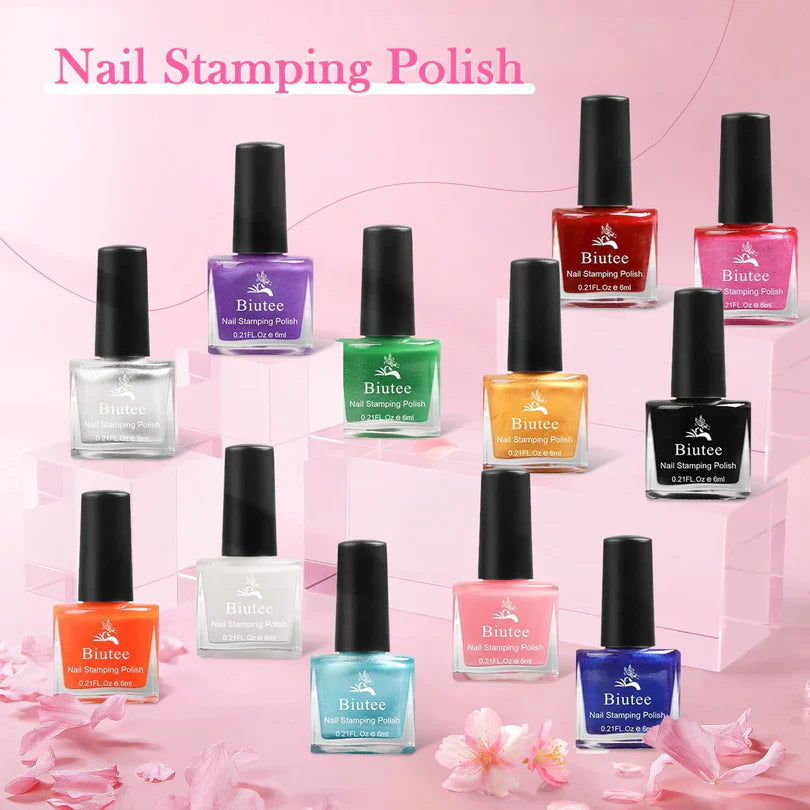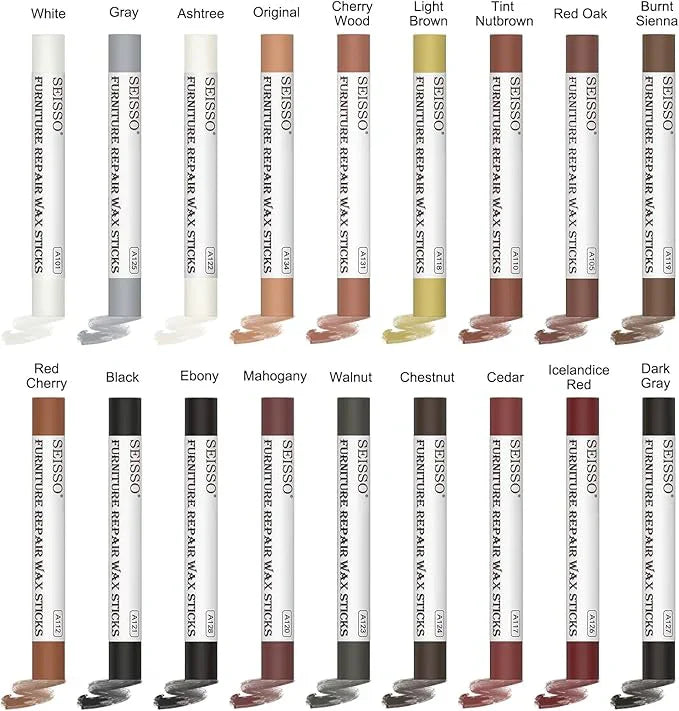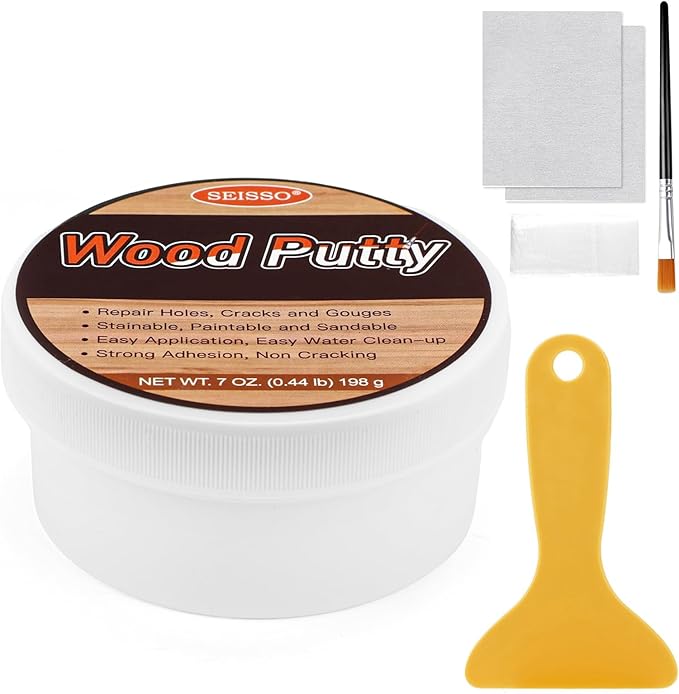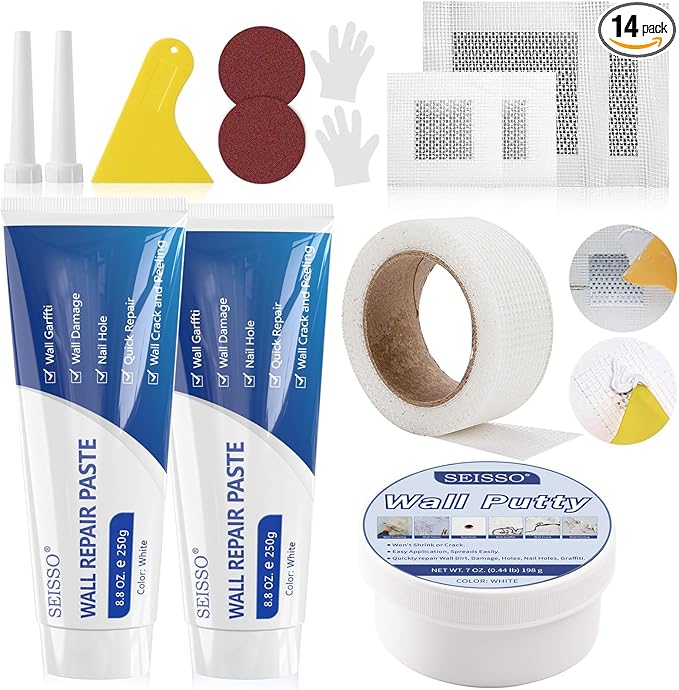Restore scratches, fill holes, and make old wood look new again — a practical, safe, and easy-to-use solution for DIYers and pros.
1. Why wood putty — material comparison & when to choose it
When you face small-to-medium surface damage on wooden surfaces, you have several repair options. Understanding the material differences makes choosing the right one easier:
-
Wood Putty (like SEISSO)
Composition: water-based, paste-like compounds (non-toxic here).
Best for: cosmetic repairs — scratches, small dents, veneer gaps, surface chips.
Finishing: sandable, paintable & stainable.
Strength: not structural; mainly cosmetic. -
Wood Filler (solvent or water-based heavier formulas)
Best for: deeper holes where a firmer fill is desired. Some cure very hard.
Finishing: many are sandable and paintable; stainability varies. -
Epoxy / Two-part fillers
Best for: structural repairs, deep voids, load-bearing fixes, or where strong screw holding is needed.
Finishing: very strong; can be shaped and sanded once cured. -
Wax or putty sticks
Best for: minor surface color touch-ups, quick concealment. Not sandable or paintable.
When to use wood putty: choose putty when the goal is to make a finished surface look continuous again — for furniture, door scuffs, veneer scratches, or small holes. For structural or load-bearing needs (e.g., replacing rotten wood, holding screws) opt for epoxy or a dowel + glue solution.
2. Why SEISSO Wood Putty is popular
-
Beginner friendly: water-based and easy to apply — excellent for homeowners who want fast results without special tools.
-
All-in-one kit: includes scraper and sandpaper so users can finish with what they need.
-
Safe formula: non-toxic ingredients reduce health concerns compared with solvent-heavy alternatives.
-
Finish flexibility: paintable & stainable so you can match new work to an existing finish.
- Durable surface: white, scrub-resistant finish for long-term protection on repaired areas.
3. Typical use cases & what it can repair
SEISSO Wood Putty is tailored for everyday household repairs:
- Filling nail holes, small gouges, or dents in tables, chairs, cabinets.
- Repairing scratches and edge wear on veneers.
- Concealing small holes or graffiti on wooden doors/frames.
- Touching up scuffed flooring planks (cosmetic only).
- Quick shop or landlord repairs before staging or move-out.
Expected results: seamless cosmetic repairs — smooth, sanded surface that accepts paint or stain to blend with the surrounding wood. Not intended to replace structural joinery or replace missing wood for heavy loads.
4. How to use SEISSO Wood Putty — practical step-by-step (how to wood putty)
-
Prepare the area: Clean dust, grease, or loose fragments. Slightly dampen very dry surfaces if they’re powdery.
-
Scoop & apply: Use the included plastic scraper to apply putty into the defect, overfilling slightly. Press putty into grain/damage to eliminate air pockets.
-
Smooth: Remove excess with the scraper and shape roughly to the surface profile.
-
Let dry: Allow the putty to dry naturally (see FAQ below for drying guidance).
-
Sand: Use the included sandpaper to level the repair flush with the surface; progress to finer grit for a smooth finish.
-
Finish: Stain or paint the repaired area. For best stain matching, test on a scrap piece or use a stainable primer.
- Clean up: Water cleans tools and most residues since the formula is water-based. Wear gloves during application.
5. The user experience — what it feels like to work with this product
-
Texture & workability: SEISSO’s putty spreads smoothly and is forgiving to shape during the work window. It’s neither too runny nor too stiff — good for controlled fills.
-
Odor & safety: water-based and non-toxic, so odor is light compared to solvent-heavy fillers. Still, use in ventilated space and wear gloves if your skin is sensitive.
-
Sanding & finishing: sands to a smooth, powdery dust cleanly; accepts both paint and stain well with proper prep.
- Cleanup: simple — soap and water remove uncured residue from tools.
6. Who should buy this ?
- Homeowners who want to refresh furniture without replacing it.
- Landlords and property managers needing quick cosmetic fixes.
- DIY hobbyists and craft restorers.
- Small furniture shops or restorers for non-structural touch-ups.
- Anyone looking for a safe, beginner-friendly repair kit.
7. What it won’t do — limits & alternatives
Not structural: do not rely on putty alone for load-bearing areas or screw retention. If you need to hold a screw, consider:
- Replacing the hole with a glued hardwood dowel, or using epoxy-based fillers or two-part wood repair systems designed for structural strength.
- Large voids: for deep, large gaps use layered fills or epoxy; putty is best for small-to-medium surface defects.
8. FAQ
-
Can wood putty be stained/painted?
Yes — SEISSO Wood Putty is stainable and paintable. For best results, let it fully dry, sand smooth, then test stain/paint on a small area or scrap. Some color matching may require tinting the stain or using a touch-up marker. -
How long wood putty dry?
Drying time depends on depth, temperature, and humidity. Thin surface fills can become surface dry in 15–60 minutes in good conditions; deeper fills may need several hours to 24 hours to fully cure. Always check by lightly touching or sanding a small area — if it gums, give it more time. -
How to wood putty?
(See the step-by-step above.) Key tips: press putty into the defect, overfill slightly, allow full drying, then sand and finish. -
When to use wood putty?
Use putty for cosmetic repairs: scratches, shallow dents, nail holes, small veneer gaps, and surface chips. For structural repairs or screw-loads, choose alternative methods. -
Where is wood putty in seisso?
To find this product on the SEISSO site, search for “Wood Putty” or look under the Wood Repair / Furniture Repair category. (If you can’t find it, use the site search or contact customer support.) -
Which wood putty is best?
The “best” putty depends on needs. Prioritize: paintability/stainability, sandability, safety (non-toxic), included tools, and ease of cleanup. For a general household kit, SEISSO’s combination of non-toxic water-based formula, included scraper & sandpaper, and stainable/paintable finish makes it an excellent all-round choice. -
Why is wood putty non hardening?
Some putties (especially oil-based) remain soft or don’t harden because their formulation is intended for flexibility or because they never cure in thick layers. SEISSO’s water-based putty is formulated to dry naturally; if a putty doesn’t harden, it may be too thick, applied in too large a volume, or exposed to conditions that prevent curing (extreme cold or high moisture). -
Will wood putty hold a screw?
Generally no — putty is cosmetic and lacks the structural grip needed for screws. For re-anchoring screws, use a glued dowel, wood glue + plug, or a structural epoxy filler designed to hold fasteners.
9. Conclusion — why choose SEISSO Wood Putty
If you want a safe, easy, and versatile solution for everyday furniture and surface repairs, SEISSO Wood Putty hits the sweet spot: non-toxic, water-based, sandable, stainable/paintable, and supplied with the basic tools to finish the job. It’s built for the routine fixes that keep your home looking cared for — without costly replacements.
Notes: Wear gloves when using. Let dry naturally; then sand/paint/stain.
🛒 Ready to restore? Add SEISSO Wood Putty to your cart and bring your wooden furniture back to life: SEISSO Wood Putty – Paintable & Stainable Furniture Repair Filler




